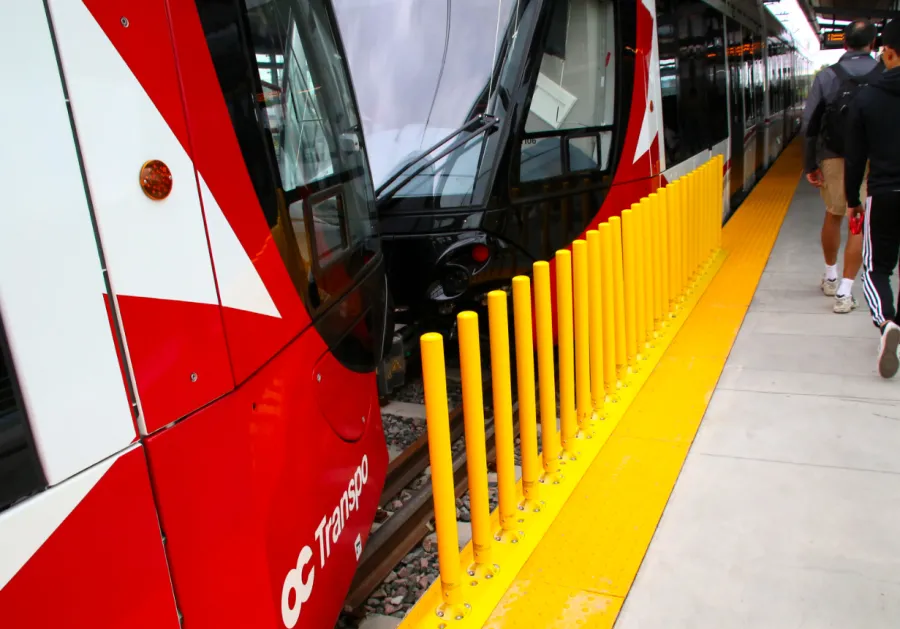Infrastructure and Track Maintenance workers at Alstom join OC Transpo union, ATU local 279 in Ottawa

FOR IMMEDIATE RELEASE
OTTAWA - Approximately 35 workers who work on the Confederation Line are the newest members of Amalgamated Transit Union local 279 representing workers at OC Transpo, Paratranspo, the Royal Canadian Mint and Alstom. These workers are employees of Alstom Transport Canada and perform infrastructure maintenance and warehouse work on the Confederation line. This work includes guideway maintenance, power technicians, signalling and communications and other duties. They join their colleagues in vehicle maintenance who perform work on the LRT vehicles and are already unionized.
The workers exercised their freedoms under the Canada Labour Code to join the local union. In 2017, the Trudeau Government reinstated ‘card-check’ to the Canadian Industrial Relations Board, which means that the board can certify a bargaining unit if it is satisfied that a majority of employees have joined the union by signing union cards and paying the mandatory $5 initiation fee.
“The union drive began when workers in all job classes reached out to the local and made a plan with this committee to make contact with a majority of employees.” Said Clint Crabtree, President of Ottawa ATU Local 279. “Due to public health guidelines and provincial stay-at-home orders, the local union was unable to hold membership meetings; instead, they conducted one-on-one phone outreach and invited workers to the local union hall one by one or in pairs to sign union membership cards and meet local union representatives.”
This victory has another major significance for workers in ATU which is that the federal jurisdiction of the Ottawa transit network remains intact. Since 2019, other unions have moved into transit but have filed at the Ontario Labour Relations Board. The Ontario Labour Relations Act is a much weaker form of legislation having been reduced and attacked by the Progressive Conservative Party of Ontario. One certification of transit workers at the Ontario Labour Relations Board took almost two years. The ATU won federal card-check in a few short weeks due to card-check and the powers of the board to decide certification without hearings. Keeping transit federally regulated was a major priority for the local for which they were successful.
This successful certification campaign was a long time coming. Local 279 had previously certified a group of Alstom employees doing vehicle maintenance. The local successfully got a recognition clause placed in the original RFP. However, the language only covered vehicle maintenance and not track or infrastructure maintenance. Local 279 won a CBA for Alstom in 2017.
The infrastructure maintenance workers will be looking to fix a number of issues. Some issues include more rigid job classification between skilled trades and less floating. Hours of work is also a big issue as 12-hour shifts are the norm and the weekly rotation between days and nights provides little work-life balance. Winning a collective agreement will also provide more security and clarity on compensation. Workers told union representatives that they were denied a raise in 2020.
“This successful certification is a milestone for Canada’s largest transit union who have a national campaign to unionize electric streetcars and LRVs work.” said John Di Nino, ATU Canada National President. “The Amalgamated Transit Union was originally formed as the Amalgamated Association of Street Railway Employees (AASRE) or ‘the streetcar union’. Its primary jurisdiction was an industrial model encompassing all employees – operations and maintenance – in the performance of passenger transport on electric propulsion vehicles.”
As public transit shifted from electric rail to diesel automotive buses, the AASRE transformed into the Amalgamated Transit Union. Since the 2000s, there has been a major shift in Canadian cities toward light-rail vehicles under the public-private partnership model. While this might represent a better approach to carbon emissions, public-private partnerships without unions are typically detrimental to worker rights and living standards. The difference between non-union work and ATU contracts is typically in the level of compensation and the hours of work. Whereas most ATU contracts secure overtime pay after eight hours a day, non-union work typically sees straight pay even when workers labour longer than eight hours in a day. This is because employers take advantage of weak employment standards laws and overtime averaging.
“We’re happy to welcome Alstom workers into the ATU family.” Said ATU International President John Costa. “We look forward to working with these workers and striking a fair collective agreement for them in the coming year.”
-30-
For Media Inquiries:
Clint Crabtree, President - ATU 279
613-286-5813
c.crabtree@atu279.ca
